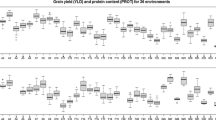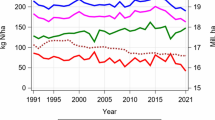Summary
Many aeas of world, particular those where agriculture is largely practiced by resource-poor farmers with little or no use of external inputs, have not benefitted from the spectacular yield increases achieved by the combination of modern breeding technologies and use of inputs. The paper argues that because breeding is mostly conducted in presence of high inputs, it has systematically missed the opportunity to exploit genetic differences at low levels of inputs. Many studies show that these differences do exist, particularly in the case of fertilizers, and that these differences can only be identified is selection is conducted under the target level of inputs. Although this was predicted by theory more than 40 years ago, and has been supported by a large body of experimental data, very few breeders select in sub-optimal or stress conditions. The most common justification is the high environmental variation, and hence the lower heritability expected in low input conditions. While this is not supported by experimental evidence, the paper shows that in the case of a typical crop grown in low-input and climatically marginal conditions such as barley, genetic gains are possible by using locally adapted germplasm and by selecting in the target environment. Similar conclusions, in relation to the use of a low-input selection environment, have been reached recently in maize. It is concluded that the best avenue to a sustainable increase of agricultural production in low-input agricultural systems is through locally based breeding programs.
Similar content being viewed by others
References
Allard R.W. & P.E. Hansche, 1964. Some parameters of population variability and their implications in plant breeding. Advances in Agronomy 16: 281–325.
Allen F.L., R.E. Comstock & D.C. Rasmusson, 1978. Optimal Environments for Yield Testing. Crop Science 18: 747–751.
Atlin G.N. & K.J. Frey, 1989a. Predicting the relative effectiveness of direct versus indirect selection for oat yield in three types of stress environments. Euphytica 44: 137–142.
Atlin G.N. & K.J. Frey, 1989b. Breeding crop varieties for low-input agriculture. American Journal of Alternative Agriculture 4: 53–58.
Atlin G.N. & K.J. Frey, 1990. Selecting oat lines for yield in low-productivity environments. Crop Science 30: 556–561.
Attene, G., G.F. Delogu, M. Lendini, R. Papa, R. Santilocchi & F. Veronesi, 1995. Risposta dell'orzo (Hordeum vulgare L.) a diversi livelli di intensificazione culturale. Rivista di Agronomia (in press).
Austin R.B., M.A. Ford & C.L. Morgan, 1989. Genetic improvement in the yield of winter wheat: a further evaluation. J. Agric. Sci. Camb. 112: 295–301
Balko L.G. & W.A. Russell, 1980. Effects of rates of nitrogen fertilizer on maize inbred lines and hybrid progeny. I. Prediction of yield responses. Maydica 25: 65–79.
Blum A., 1988. Plant breeding for stress environments. CRC Press, Boca Raton, Florida.
Blum A., 1993. Selection for sustained production in water-deficit environments. pp 343–347 in: International Crop Science I, Crop Science Society of America, Madison, WI.
Boyer J.S., 1982. Plant Productivity and Environment. Science 218: 443–448.
Bradford, G.E. & Y.M. Berger, 1988. Breeding strategies for Small Ruminants in Arid and Semi-Arid Areas. In: E.F. Thomson & F.S. Thomson (Eds) Increasing Small Ruminant Productivity in Semi-Arid Areas pp. 95–109.
Bramel-Cox, P.J., T. Barker, F. Zavala-Garcia & J.D. Eastin, 1991. Selection and testing environments for improved performance under reduced-input conditions. In: D.A. Sleeper, T.C. Barker & P.J. Bramel-Cox (Eds) Plant breeding and sustainable agriculture, Considerations for Objectives and Methods, pp. 29–56. CSSA Special Publication no. 18.
Breese E.L., 1969. The measurement and significance of genotype-environment interactions in grasses. Heredity 24: 27–44.
Bulman P., D.E. Mather & D.L. Smith, 1993. Genetic improvement of spring barley cultivars grown in eastern Canada from 1910 to 1988. Euphytica 71: 35–48.
Castleberry R.M., C.W. Crum & C.F. Krull, 1984. Genetic Yield Improvement of US Cultivars under Varying Fertility and Climatic Environments. Crop Science 24: 33–36.
Ceccarelli, S., 1993. Plant breeding technologies relevant to developing countries. In: M. Gill, E. Owen, G.E. Pollot & T.L.J. Lawrence (Eds) Animal production in developing countries, Occasional Publication No. 16 — British Society of Animal Production, pp. 37–46.
Ceccarelli S., 1994. Specific adaptation and breeding for marginal conditions. Euphytica 77: 205–219.
Ceccarelli S., S. Grando & J.A.G.van Leur, 1987. Genetic diversity in barley landraces from Syria and Jordan. Euphytica 36: 389–405.
Ceccarelli S. & S. Grando, 1991a. Selection environment and environmental sensitivity in barley. Euphytica 57: 157–219.
Ceccarelli S. & S. Grando, 1991b. Environment of selection and type of germplasm in barley breeding for stress conditions. Euphytica 57: 207–219.
Ceccarelli, S. & S. Grando, 1995. Drought as a challenge for the plant breeder. In: E. Belhassen (Ed) Drought Tolerance in Higher Plants: Genetical, Physiological and Molecular Biological Analysis. Kluwer Academic Publishers (in press).
Evans L.T., 1980. The Natural History of Crop Yield. American Scientist 68: 388–396.
Evans L.T. & I.F. Wardlaw, 1976. Aspects of the comparative physiology of grain yield in cereals. Advances in Agronomy 28: 301–359.
Falconer D.S., 1952. The problem of environment and selection. American Naturalist 86: 293–298.
Falconer D.S., 1989. Introduction to quantitative genetics. 3rd edn. Longmann, London.
Falconer D.S., 1990. Selection in different environments, effects on environmental sensitivity (reaction norm) and on mean performance. Genetic Research Cambridge 56: 57–70.
Falconer D.S., 1993. Quantitative Genetics in Edinburgh: 1947–1980. Genetics 133: 137–142.
Fischer R.A. & R. Maurer, 1978. Drought Resistance in Spring Wheat Cultivars. I. Grain Yield Responses. Aust J Agric Res 29: 897–912.
Fischer R.A. & J.T. Wood, 1979. Drought Resistance in Spring Wheat Cultivars. III* Yield Association with Morphophysiological Traits. Aust J Agric Res 30: 1001–1020.
Francis C.A., 1986. Multiple croppping systems. New York: Macmillan 383 pp.
Frey K.J., 1964. Adaptation Reaction of Oat Strains Selected Under Stress and Non-Stress Environmental Conditions. Crop Science 4: 55–58.
Grisley W. & M. Shamambo, 1993. An analysis of the adoption and diffusion of carioca beans in Zambia resulting from an experimental distribution of seed. Expl Agric 29: 379–386.
Hardon, J.J. & W.S. de Boef, 1993. Linking farmers and breeders in local crop development. In: W. de Boef, K. Amanor, K. Wellard & A. Bebbington (Eds) Cultivating Knowledge. Genetic diversity, farmer experimentation and crop research, pp. 64–71. Int Techn Publ Ltd.
Haugerud A. & M.P. Collinson, 1990. Plants, genes and people: improving the relevance of plant breeding in Africa. Expl Agric 26: 341–362.
Jansen H.G.P., T.S. Walker & R. Barker, 1990. Adoption Ceilings and Modern Coarse Cereal Cultivars in India. Amer J Agr Econ 72: 653–663.
Johnson G.R. & K.J. Frey, 1967. Heritabilities of Quantitative Attributes of Oats (Avena sp.) at Varying Levels of Environmental Stress. Crop Science 7: 43–46.
Khan A. & L.A. Spilde, 1992. Response of hard red spring wheat genotypes to management systems. Crop Science 32: 206–212.
Lafitte H.R. & G.O. Edmeades, 1994. Improvement for tolerance to low soil nitrogen in tropical maize. I. Selection criteria. Field Crops Research 39: 1–14.
Martin G.B. & M.W. Adams, 1987. Landraces of Phaseolus vulgaris (Fabaceae) in Northern Malawi. II. Generation and Maintenance of Variability. Economic Botany 41: 204–215.
Maurya D.M., A. Bottral & J. Farrington, 1988. Improved livelihoods, Genetic Diversity and Farmer participation: A strategy for breeding in rainfed areas of India. Expl. Agric. 24: 311–320.
McDonald G.K., 1989. The contribution of nitrogen fertiliser to the nitrogen nutrition of rainfed wheat crops in Australia: a review. Aust J Expl Agric 29: 455–481.
Muruli B.I. & G.M. Paulsen, 1981. Improvement of Nitrogen Use Efficiency and its relationship to other traits in maize. Maydica 26: 63–73.
Norse D., 1992. A new strategy for feeding a crowded planet. Environment 34: 6–39.
Pederson D.G. & A.J. Rathjen, 1981. Choosing trial sites to maximize selection response for grain yield in spring wheat. Aust J Agric Res 32: 411–424.
Pfeiffer W.H., 1988. Drought Tolerance in Bread Wheat — Analysis of Yield Improvement over the Years in CIMMYT Germplasm. In: A.R. Klatt (Ed.) Wheat production constraints in tropical environments, pp. 274–284. CIMMYT, Mexico DF, Mexico.
Pimbert, M.P., 1994. The need for another research paradigm. Seedling, July 1994: 20–25.
Poutala R.T., O. Kuoppamäki, J. Korva & E. Varis, 1994. The performance of ecological, integrated and conventional nutrient management in cereal cropping in Finland. Field Crops Research 37: 3–10.
Rathjen, A.J. & D.G. Pederson, 1986. Selecting for improved grain yields in variable environments. In: Plant Breeding Symposium, pp. 104–115. DSIR, Christchurch, N.Z. Agronomy Society Special Publication No. 3.
Rosielle A.A. & J. Hamblin, 1981. Theoretical aspects of Selection for Yield in Stress and Non-Stress Environments. Crop Science 21: 943–946.
Roy N.M. & B.R. Murty, 1970. A selection procedure in wheat for stress environments. Euphytica 19: 509–521.
Selmani A. & C.E. Wassom, 1993. Daytime chlorophyll fluorescence measurement in field grown maize and its genetic variability under well-watered and water-stressed conditions. Field Crops Research 31: 173–184.
Simmonds N.W., 1984. Principles of crop improvement. Longman, London and New York, pp. 408.
Simmonds N.W., 1991. Selection for local adaptation in a plant breeding programme. Theoretical Applied Genetics 82: 363–367.
Singh M. & S. Ceccarelli, 1995. Estimation of heritability using varietal trials data from incomplete blocks. Theoretical Applied Genetics 90: 142–145.
Smith M.E., W.R. Coffman & T.C. Barker, 1990. Environmental effects on selection under high and low input conditions. In: M.S. Kang (Ed.) Genotype-by-environment interaction and plant breeding, pp. 261–271. Dept of Agron Louisiana State Agric Experiment Stn, Baton Rouge, USA.
Sperling L., M.E. Loevinsohn & B. Ntabomvura, 1993. Rethinking the farmer's role in plant breeding: local bean experts and onstation selection in Rwanda. Expl Agric 29: 509–519.
van Oosterom E.J., D. Kleijn, S. Ceccarelli & M.M. Nachit, 1993. Genotype × Environment Interactions of barley in the Mediterranean region. Crop Science 33: 669–674.
Ward P.J., 1994. Parent-offspring regression and extreme environments. Heredity 72: 574–581.
Weltzien E. & G. Fischbeck, 1990. Performance and Variability of Local Barley Landraces in near-Eastern Environments. Plant Breeding 104: 58–67.
Zavala-Garcia F., P.J. Bramel-Cox, J.D. Eastin, M.D. Witt & D.J. Andrews, 1992. Increasing the Efficiency of Crop Selection for Unpredictable Environments. Crop Science 32: 51–57.
Author information
Authors and Affiliations
Rights and permissions
About this article
Cite this article
Ceccarelli, S. Adaptation to low/high input cultivation. Euphytica 92, 203–214 (1996). https://doi.org/10.1007/BF00022846
Issue Date:
DOI: https://doi.org/10.1007/BF00022846




